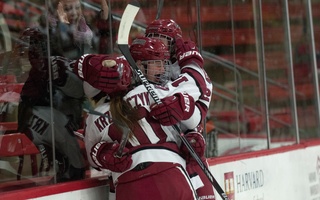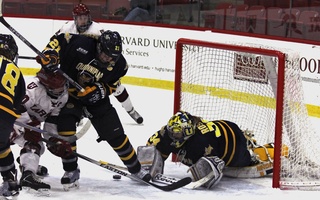In the first three months of play, the Harvard women’s ice hockey team suffered losses, losses, and still more losses. In the first 11 games, the Crimson emerged victorious exactly once— against Dartmouth in late October.
Nevertheless, the outlook was hopeful when Harvard rung in the new year. In the team’s last game of 2016, the Crimson had tied No. 7 Colgate, 3-3, to halt a nine-game losing skid.
Harvard’s 2017 timetable wasted no time in providing a new challenge. On Jan. 6, Harvard tripped to Hamden, Conn., to square off against No. 8 Quinnipiac and then visited Princeton for a Saturday matinee.
The matchup with the Bobcats (15-5-4, 8-3-2) marked yet another ranked opponent on Harvard’s schedule—the Crimson has battled eight teams in the top 25 so far. Both the Tigers (12-6-2, 8-4-1) and Quinnipiac were familiar foes, having defeated Harvard earlier in the season by scores of 2-1.
The Crimson improved slightly on those earlier results. This time Harvard left the back-to-back contests with a tie and a loss.
“We played really hard in both games,” junior defenseman Chelsea Ziadie said. “Our team came out really strong in the first period…and that was one of our team goals.”
PRINCETON 2, HARVARD 1
Harvard failed to build upon the positive momentum it generated in the final third of its match against Quinnipiac. This time, it was the opposition who had the last laugh.
Despite entering the third period with a one-goal lead, the Crimson conceded two scores in the final 20 minutes en route to defeat. Three costly penalties, including a bench minor for too many players on the ice, hampered Harvard’s third period performance, as Princeton junior forward Kiersten Falck ultimately delivered the final blow on the power play.
“[Power play opportunities] are game changers,” Ziadie noted. “We’ve lost some games by one goal when we’ve been on the [penalty] kill and the other team has scored…. Even in the second period, there was a point where we were getting penalties, and the momentum shifted.”
After a goalless first frame, the Crimson opened the scoring in the second period courtesy of sophomore defenseman Kaitlin Tse’s stick. The man-up tally was the only blip in an otherwise stingy game for Tigers freshman goaltender Steph Neatby, whose 32 saves helped her improve to 6-1-0 on the season, good for the second-best win percentage in the ECAC.
The Saturday afternoon showdown was otherwise closely contested as each team notched a power play goal. Harvard emerged with a slim margin in shots (33-31) and faceoff wins (27-26) while both teams frequented the penalty box—the visitors six times and the hosts five.
Compared to its season average, the Crimson well surpassed its shots per game mark of 24.2 but was destined for a collision course with a hot goaltender who answered all but one attempt. Harvard’s relative scoring success on the road this year—1.67 goals per game as opposed to 1.40 at Bright-Landry—was not enough to crack the code of Neatby’s four-by-six safe.
“Off of those [33] shots, we had a ton of rebounds, and we didn’t take advantage of them,” Ziadie lamented. “One of the areas of our game that we wanted to improve was shooting a lot…and the next step will be to get to those rebounds and capitalize on those opportunities.”
On the other side of the ice, Harvard senior goaltender Molly Tissenbaum is still in search of her first victory of the season, as she moved to 0-7-0 after defeat at the hands of the Tigers. The Toronto native boasts a solid .925 save percentage this season but has not received the goal support from her skaters needed to outpace her 2.82 goals against average.
Read more in Sports
Notebook: Depth, Defense Key Men's Basketball in Ivy Opener

















